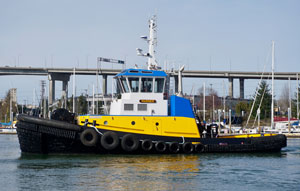Capt. Mark Williamson steered Western Towboat’s newest harbor tug into Elliott Bay on a cool, clear late February day. Other mariners working in the busy harbor took notice.
“That’s a nice-looking boat,” said David Trickett, who oversaw lightering of gypsum from the bulk carrier Astoria Bay anchored nearby.
“Roger that,” Williamson responded. “Taking it for a test run here.”
Mariner is the third of Western’s Westrac-series tugboats, and like its two predecessors Westrac and Westrac II, it was built at the company’s shipyard along Seattle’s Lake Union. Capt. Russell Shrewsbury, whose grandfather started Western Towboat in 1948, worked with KraftMar Design and Argonaut Marine, also of Seattle, to fine-tune the plans.
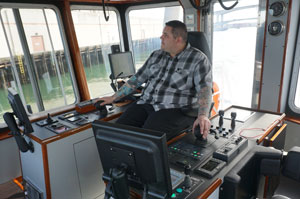 |
|
Capt. Russell Shrewsbury, seated at the controls, worked with KraftMar and Argonaut Marine to update Western’s proven Westrac design. |
Western began integrating the 80-by-32-foot Mariner into its harbor fleet in February. Williamson, a 20-year employee with the company, gave the new vessel high marks after his first turn at the controls.
“It is just a lot more power than I am used to, but it’s real steady in the water,” he said.
Shrewsbury spent years thinking about upgrades to the Westrac design first conceived by his father, Bob Shrewsbury, in the mid-1980s. Mariner retained many characteristics of the Westrac series, particularly its nimbleness while working in the narrow Duwamish Waterway. That said, the tug is loaded with modern amenities designed for efficiency, crew comforts and reduced maintenance costs.
Mariner shares the same distinctive look as its predecessors, but with almost 4,000 hp it is 65 percent more powerful than Westrac II, built in 1995. Mariner is 2 feet wider at the beam for better stability. It’s also 1 foot deeper at the keel for improved tracking when handling barges — which accounts for roughly 75 percent of Western’s harbor work.
The winch package and z-drives also changed on the new vessel, in part to accommodate its more powerful engines. Mariner delivers almost 55 tons of bollard pull, compared to about 25 tons for Westrac II.
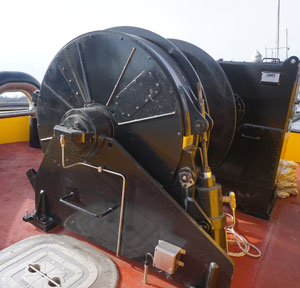 |
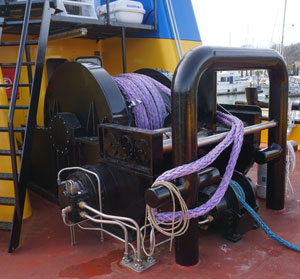 |
|
|
The DMT Marine Equipment winch on Mariner’s bow, left, is the company’s first installation on a U.S. tugboat. Western Towboat’s shipyard crews built the towing winch, right, at the company’s yard. |
||
These gains in power and pull ensure Western can continue serving existing customers with bigger ships. It will allow for local rescue tows and help with maneuvering massive cargo barges bound for Alaska. Western operates a fleet of z-drive oceangoing tugboats that tow containers, vehicles and other freight to Alaska for Alaska Marine Lines.
“When we built the (first two) Westracs, the barges that were going to Alaska were 300 feet long. Now they are 420 by 105 (feet), so it is nice to have the extra power,” Shrewsbury said. “Being in the 4,000 (hp) range, we can do a lot more with these boats but we are in the same size power package.
“We are not trying to be ship dockers in Puget Sound,” he continued. “We just want to have the ability to do these jobs if we need to.”
Propulsion aboard Mariner comes from twin Caterpillar 3512 Tier 3 mains producing 1,970 hp each, paired with Schottel z-drives with Nautican propellers and nozzles through Centa carbon-fiber shafts. Two 75-kW John Deere generators installed forward of the main engines provide electrical power.
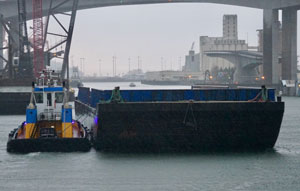 |
|
Mariner guides a barge along the Duwamish Waterway. |
The deck equipment also represents an upgrade over the earlier tugs. The DMT Marine Equipment ship-handling winch installed on the bow is the Romanian company’s first installation on a U.S. tugboat. The single-drum hydraulic winch has 40 tons of line pull and is spooled with 500 feet of 2.5-inch Cortland Plasma line.
Shrewsbury chose DMT after conducting extensive research. DMT winches, he said, are common in Europe and found on some Canadian tugs. Shrewsbury liked DMT’s service and willingness to customize the winch.
Western Towboat port engineer Ed McAvoy designed the hydraulic towing winch installed aft of the house. The single-drum unit is loaded with 1,800 feet of 1.75-inch galvanized steel towing wire and 200 feet of 2.5-inch Cortland Plasma line. A Pullmaster M50 winch with 25 tons of line pull provides additional capability.
Western’s shipyard fabricated the stern rollers and hydraulic towing pins, along with the bow staple and H-bitts on the port and starboard sides. The upgraded Schuyler Companies and Shibata fendering package is softer along the bow and runs higher along the bulwarks to protect lines when towing barges on the hip.
“We just need to keep our versatility open,” Shrewsbury said. “We can do anything with this boat.”
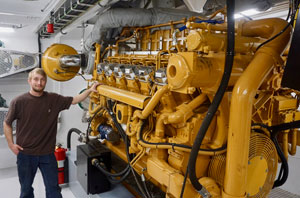 |
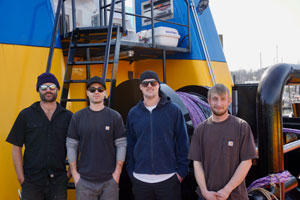 |
|
|
Engineer James Gaines alongside one of Mariner’s two Cat 3512 engines. |
Western Towboat deckhand Andrew Donaldson, mate Calvin Grenkavich, Capt. Mark Williamson and Gaines on Mariner’s aft deck. |
Mariner is typically crewed with a master, mate and deck hand/engineer for work within the Duwamish. A a second deck hand comes along for jobs farther afield. Although there are bunks for five people, most crew go home when their shifts end. Even so, Shrewsbury made sure to include plenty of comforts for downtime between jobs or rare occasions when crew sleep on board.
Mariner has an open-concept galley, mess and lounge area, along with a head and captain’s cabin on the main level. The settee in the lounge, made of leather instead of vinyl, is long enough for a crewman to lie down during spare minutes. The space is outfitted with rich mahogany wood accents, and a separate refrigerator near the wheelhouse stairs is loaded with grab-and-go soft drinks.
Other decisions regarding the crew spaces will save time, money and future headaches. The fridge, for instance, is an oversized household unit that can be replaced for roughly the same cost as repairing a marine unit just one time. The double bunks fit full-size beds, eliminating the need for slightly narrower — and much pricier — custom-made mattresses.
“Our biggest thing is, if we are going to ask people to be away from home for six months a year, we want it to be as nice, or nicer, than home,” Shrewsbury said.
The wheelhouse has been upgraded too, with full windows for all-around visibility and upper windows for better views when working under a ship’s flare. Furuno supplied much of the marine navigation electronics, paired with a Rose Point Navigation Systems electronic chart system. The wheelhouse has Bluetooth connectivity for hands-free phone communication.
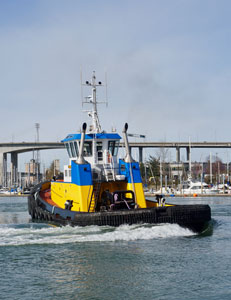 |
|
The upper exhaust stacks on Mariner can be removed, leaving just enough space for each main engine to be lifted through the opening. |
The hull and decks are painted with a Blue Seal epoxy-fiberglass coating that has proven its worth on Western’s tugs making year-round trips to Alaska. Shrewsbury expects to get 15 years out of the deck on Mariner. The company also uses it on the nozzles to protect against cavitation.
“We put it on Arctic Titan in 2012, and we did the whole hull and then put an antifouling coating over it,” he said. “We haven’t had to blast the hull yet. It’s rock-hard.”
Bob Shrewsbury started Western Towboat in 1948, and his son Bob Shrewsbury Jr. remains company president. Russell and his brother Ross, also a Western captain, still run tugs when they’re not busy working in the office.
Russell Shrewsbury recognized the irony around building the boat he wanted at a time when he’s spending less time on the water. “It’s going to be really hard for me to let go,” he said. “It’s like getting a brand-new car and just giving it away.”

